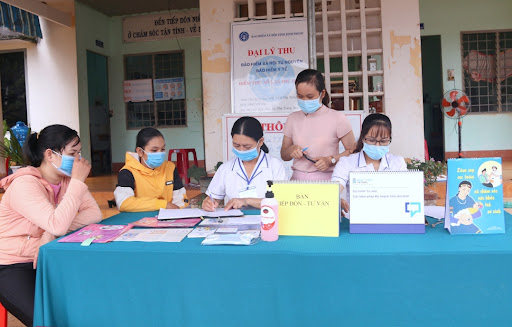Healthcare service package for women implemented by the commune health stations in Vietnam from December 19, 2024
14:09, 05/11/2024
Below is the content of the women's healthcare package implemented by the commune health stations in Vietnam from December 19, 2024.

Healthcare service package for women implemented by the commune health stations in Vietnam from December 19, 2024 (Image from the internet)
On November 4, 2024, the Minister of Health of Vietnam issued Circular 30/2024/TT-BYT stipulating the list and content of basic health care service packages implemented by the commune, ward, or commune-level town health stations.
Healthcare service package for women implemented by the commune health stations in Vietnam from December 19, 2024
In Section II of the Annex issued with Circular 30/2024/TT-BYT, the regulations for the health care service package for women implemented by the commune health stations in Vietnam include:
| No. | List and Detailed Content |
|---|---|
| II. Health Care Service Package for Women | |
| Service 5 | Health care for pregnant women and prenatal screening |
| 1. | Implementation location: at the commune health stations, health facility, home, or service delivery point in the community. |
| 2. | Target group: pregnant women. |
| 3. | Frequency: 02 times per individual during the first 3 months and the middle 3 months of pregnancy. |
| 4. | Content: Apart from regular prenatal check-ups according to the National Guidelines on Reproductive Health Care Services covered by health insurance, the following should be additionally performed: - Counseling on the purpose, meaning, benefits, potential risks of the techniques applied, and the sequence of steps during prenatal screening for each specific case; - Counseling on common mother-to-child transmissible diseases and preventive measures; - Counseling and rapid testing for HIV, hepatitis B, and syphilis (once per pregnancy); - Nutritional care advice for women during pregnancy, breastfeeding, and child nutrition by breastfeeding; - Counseling and guidance on preventing micronutrient deficiencies; - Providing additional iron and folic acid supplements (if the pregnant woman has not been supplemented with these two micronutrients); - Recording the results of regular health check-ups in the Health Monitoring Record and the Mother and Child Health Monitoring Book. |
| 5. | Implementation procedures and guidelines as follows: - Circular 34/2017/TT-BYT dated August 18, 2017, by the Minister of Health providing guidance on prenatal and neonatal counseling, screening, diagnosis, and treatment; - Circular 30/2019/TT-BYT dated December 3, 2019, by the Minister of Health amending and supplementing several articles of Circular 34/2017/TT-BYT dated August 18, 2017, by the Minister of Health providing guidance on prenatal and neonatal counseling, screening, diagnosis, and treatment; - Decision 140/QD-BYT dated January 20, 2020, by the Minister of Health issuing the Mother and Child Health Monitoring Book template for use for pregnant women and children up to 6 years old at health facilities; - Decision 1021/QD-BYT dated February 4, 2021, by the Minister of Health issuing the electronic version of the Mother and Child Health Monitoring Book; - Decision 1807/QD-BYT dated April 21, 2020, by the Minister of Health issuing guidance on technical expertise in prenatal and neonatal screening, diagnosis, and treatment; - Decision 2834/QD-BYT dated July 4, 2019, by the Minister of Health issuing technical guidance on interventions to prevent HIV, hepatitis B, and syphilis transmission from mother to child; - Decision 4128/QD-BYT dated July 29, 2016, by the Minister of Health issuing the national guidelines on reproductive health care services; - Decision 4944/QD-BYT dated November 27, 2014, by the Minister of Health issuing national guidelines on prevention and control of micronutrient deficiencies. |
| Service 6 | Management and care for pregnant women at high risk of fetal anomalies after prenatal screening |
| 1. | Implementation location: at the commune health stations, at home, or at a community service delivery point. |
| 2. | Target group: pregnant women with prenatal screening results indicating high risk of fetal anomalies as per higher-level directions. |
| 3. | Frequency: 01 time per month. |
| 4. | Content: - Provide information on prenatal diagnosed fetal anomalies; possible risks and consequences of continuing the pregnancy or terminating it for each specific case; advise pregnant women on selecting appropriate care solutions, including pregnancy termination due to fetal anomalies if necessary; - Compile statistics, report, archive records, manage after screening identifying high-risk fetuses for diseases such as Down syndrome (Trisomy 21); Edward syndrome (Trisomy 18); Patau syndrome (Trisomy 13); congenital hemolytic anemia (Thalassemia); detectable anomalies by ultrasound such as neural tube defects, abdominal wall defects, and other hereditary or non-hereditary diseases; - Manage, advise pregnant women with prenatal screening results indicating high risk of fetal anomalies as per higher-level directions. |
| 5. | Implementation procedures and guidelines according to: - Circular 34/2017/TT-BYT dated August 18, 2017, by the Minister of Health providing guidance on prenatal and neonatal counseling, screening, diagnosis, and treatment; - Circular 30/2019/TT-BYT dated December 3, 2019, by the Minister of Health amending and supplementing several articles of Circular 34/2017/TT-BYT dated August 18, 2017, by the Minister of Health providing guidance on prenatal and neonatal counseling, screening, diagnosis, and treatment; - Decision 1807/QD-BYT dated April 21, 2020, by the Minister of Health issuing guidance on technical expertise in prenatal and neonatal screening, diagnosis, and treatment. |
| Service 7 | Postnatal maternal and newborn care at home |
| 1. | Implementation location: at home. |
| 2. | Target group: mothers in the postpartum period (42 days after birth) and newborns. |
| 3. | Frequency: - For childbirths at medical facilities: 01 time in the first week after birth, except in cases with a medical stay indication, performed within 07 days after leaving the facility; - For childbirths outside medical facilities: 02 times, with the first time as soon as information about the delivery is received, and the second within 07 days after the first time. |
| 4. | Content: - For mothers: + Check general health status; uterine contraction; perineal area and discharge; breast and lactation conditions; + Guide monitoring and detection of dangerous signs in postpartum mothers and handle them; + Guide health and nutrition care for mothers; + Update health monitoring records as regulated; fill in the Mother and Child Health Monitoring Book. - For babies: + Check general health status; detect diseases or abnormalities and health risks, especially severe indicators in newborns and congenital anomalies; + Support, counsel on breastfeeding; + Guide mothers and families on childcare; monitor, detect unusual signs in newborns and handle them; + Update health monitoring records; fill in the Mother and Child Health Monitoring Book. |
| 5. | Implementation procedures and guidelines following: - Decision 4128/QD-BYT dated July 29, 2016, by the Minister of Health issuing the national guidelines on reproductive health care services; - Decision 359/QD-BYT dated January 31, 2023, by the Minister of Health issuing documents guiding early detection and intervention of child disabilities; - Decision 4944/QD-BYT dated November 27, 2014, by the Minister of Health issuing national guidelines on prevention and control of micronutrient deficiencies. |
| Service 8 | Cervical cancer screening |
| 1. | Implementation location: at the commune health stations or health facility. |
| 2. | Target group: women aged 21-65 in the commune, prioritizing ages 30-54. |
| 3. | Frequency: 01 time per woman per year. |
| 4. | Content: - Counseling on preventive methods, early detection screening for cervical cancer; - Examine the lower abdomen and groin area; - Examine external genitalia; - Vaginal examination with a speculum; - Bimanual vaginal examination; - Rectal examination; - Perform cervical observation tests with acetic acid (VIA) or Lugol’s iodine (VILI); - Counseling and referring women with positive VIA/VILI test results or suspected cancer for further examination. |
| 5. | Implementation procedures and guidelines according to: - Decision 2402/QD-BYT dated June 10, 2019, by the Minister of Health approving the guidance on prevention and control of cervical cancer; - Decision 4128/QD-BYT dated July 29, 2016, by the Minister of Health issuing the national guidelines on reproductive health care services. |
- Key word:
- healthcare service
- Women
- Commune Health Station
- Vietnam
Related Content
- Number of deputy directors of departments in Vietnam in accordance with Decree 45/2025/ND-CP
- Cases ineligible for pardon in Vietnam in 2025
- Decree 50/2025 amending Decree 151/2017 on the management of public assets in Vietnam
- Circular 07/2025 amending Circular 02/2022 on the Law on Environmental Protection in Vietnam
- Adjustment to the organizational structure of the Ministry of Health of Vietnam: Certain agencies are no longer listed in the organizational structure
- Vietnam aims to welcome 22-23 million international tourists in Vietnam in 2025
SEARCH ARTICLE
Related Article
-

- Number of deputy directors of departments in Vietnam ...
- 15:04, 05/03/2025
-

- Cases ineligible for pardon in Vietnam in 2025
- 14:43, 05/03/2025
-

- Decree 50/2025 amending Decree 151/2017 on the ...
- 12:00, 05/03/2025
-

- Circular 07/2025 amending Circular 02/2022 on ...
- 11:30, 05/03/2025
-

- Adjustment to the organizational structure of ...
- 10:34, 05/03/2025
JUST UPDATED
-

- Notable new policies of Vietnam effective as of ...
- 16:26, 11/04/2025
-
.Medium.png)
- Notable documents of Vietnam in the previous week ...
- 16:21, 11/04/2025
-
.Medium.png)
- Notable documents of Vietnam in the previous week ...
- 16:11, 02/04/2025
-
.Medium.png)
- Notable new policies of Vietnam to be effective ...
- 16:04, 02/04/2025
-
.Medium.png)
- Notable new policies of Vietnam effective from ...
- 14:51, 21/03/2025
New text summary report
-
Real estate
-
Policy analysis
-
Legal Counselling
-
Case law
-
Forms and Templates
-
New text catalog
-
New Text Notification
-
Highlights of the week
-
Finance
-
New policy in effect
-
Labor - Salary
-
Officials and civil servants
-
Land - Housing
-
Tax-free-fee
-
Custom
-
Enterprise - Investment
-
Administration
-
Insurance
-
Civil
-
Set of Laws
-
News about Case Law
-
Economy
-
Life
-
Health
-
Cultural
-
Commerce
-
Military
-
History
-
Strange story
-
Criminal
-
Traffic
-
Education
-
Other

 Article table of contents
Article table of contents
